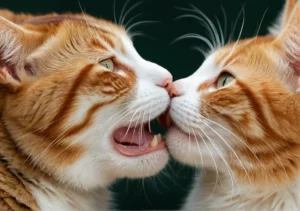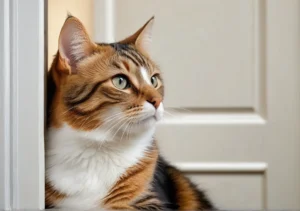Cats are fascinating creatures, and their quirks often leave us scratching our heads. One such curiosity is the mysterious “lick spot” that can appear on their fur—especially noticeable in cats that groom themselves intensively.
The lick spot generally appears due to over-grooming, which can be triggered by stress, allergies, or skin conditions. It’s a way for cats to cope with discomfort or anxiety, often causing them to focus their grooming efforts in one area.
What is a lick spot in cats
A lick spot is typically an area on a cat’s body where the fur is noticeably thinner or even completely absent due to excessive grooming. You may see it mostly on the belly, legs, or flank. These spots can appear red or irritated, suggesting the skin is receiving more attention than it should. It’s important to note that a lick spot isn’t just about appearance; it’s a sign that something might be off.
Cats engage in grooming to keep clean, but a lick spot indicates that grooming behavior has escalated, often driven by stress, boredom, or health issues. The area may feel warm to the touch due to increased blood flow as the skin reacts to irritation. Recognizing and addressing any new lick spots can prevent skin infections or other complications down the line, so it’s key to stay aware of any changes in your cat’s grooming habits.
Why do cats groom themselves excessively
Cats are natural groomers, and they often spend a good chunk of their day cleaning themselves. It not only helps keep their fur clean but also allows them to regulate body temperature and establish a sense of security. The process of licking can even have a soothing effect, creating a sense of comfort. However, when this behavior becomes excessive, it’s essential to identify the driving factors.
Several common reasons cats might groom more than usual include:
Stress and Anxiety: Major changes in the environment, such as moving or the introduction of new pets, can ramp up their stress levels, prompting over-grooming as a coping mechanism.
Boredom: An under-stimulated cat might take to grooming out of sheer boredom. Without enough mental and physical engagement, grooming can become a default activity.
Allergies: Food sensitivities or environmental allergens can lead to itchy skin, compelling your cat to lick the affected areas to alleviate discomfort.
Medical Conditions: Skin infections, parasites, or underlying health issues like hyperthyroidism may also cause an uptick in grooming.
Fleas and Other Parasites: If your cat is dealing with fleas, nits, or other parasites, they may groom excessively to relieve the itching.
Recognizing the signs of over-grooming early can help you address conditions that might be causing your cat discomfort. An extra tip? Regularly brushing your cat not only helps to reduce loose fur but also gives you a chance to check for any anomalies on their skin. For more on cat behavior and grooming, you can explore resources provided by the American Association of Feline Practitioners here.
What triggers the development of lick spots
Lick spots in cats often spring up unexpectedly and can be a little puzzling. A lick spot is basically a bald patch on your cat’s fur, typically resulting from excessive grooming in a specific area. Several triggers can set off this behavior.
Health issues can lead to these patches. Skin allergies, infections, or parasites like fleas might make a cat itch, prompting them to groom obsessively to relieve discomfort. It’s essential to keep an eye on your cat’s overall health—changes in behavior or appearance can indicate underlying problems.
Environmental factors also play a role. Cats are creatures of habit, and any disruption in their environment can lead to stress or anxiety. This includes changes such as moving to a new home, the addition of a new pet, or even the rearranging of furniture.
Lastly, some cats are simply more prone to lick spots due to their temperament or pre-existing compulsive grooming habits. If you notice a lick spot, it’s a good idea to research the potential triggers, monitor their behavior closely, and consult your veterinarian if needed.
Additional insight: Keeping your home environment calm and stable can help minimize stress-related grooming tendencies. Offering safe spaces for your cat to retreat to, playtime, and enriching activities can divert their attention and reduce anxiety.
Is stress a common cause of lick spots
Stress is a significant player in the development of lick spots. Cats have their own ways of coping with anxiety, and one of the most common is through over-grooming. This behavior can lead to bald spots, which are often mistaken for allergies or infections.
Understanding how stress affects your feline friend can shed light on this issue. A cat’s stress can stem from various sources, such as loud noises, a busy household, or changes in routine. When feeling overwhelmed, they might resort to licking as a self-soothing behavior.
If your cat is prone to licks spots, it’s worth considering the environment. Here’s a quick list of stress triggers that can lead to excessive grooming:
New pets : Introductions can upset the balance of established territories.
Changes in routine : Cats thrive on stability; disruptions can create tension.
Loud noises : Thunder, fireworks, or construction sounds can send a cat into anxiety.
Health issues : Pain or discomfort can amplify stress, making them more likely to groom.
Insufficient playtime : Lack of mental and physical stimulation can contribute to stress.
If you notice lick spots, take the time to observe your cat’s behavior and environment. Ensuring they have a safe, comfortable space and plenty of playtime can significantly alleviate stress. For more on managing cat anxiety, check out this helpful resource: The Humane Society – Cat Stress Management.
Can allergies lead to lick spots in cats
Cats can develop lick spots due to a range of both environmental and food allergies. When a cat’s skin is irritated, their natural response is to groom excessively in that area, leading to what we recognize as lick spots.
Common allergens impacting your kitty can include:
- Fleas: Even just a few bites can trigger a severe allergic reaction. Flea allergy dermatitis is quite common.
- Food: Proteins like chicken, beef, or fish can cause sensitivities. Grain allergies are also noted in some felines.
- Environmental factors: Dust mites, pollen, and mold can lead to skin irritations.
- Contact allergens: Certain materials, like plastics or cleaning products, can also be culprits.
It’s crucial to observe any patterns in your cat’s behavior or symptoms. If you notice them lingering on one spot or if their licking seems to increase after feeding or changing their environment, that can be a sign of an underlying allergy. Consulting a vet is key; they can help identify the specific allergy and recommend a tailored treatment plan.
How to identify skin conditions in cats
Recognizing skin conditions in your cat isn’t always easy, but paying close attention can make a huge difference. Look for these telltale signs:
- Itching or Scratching: If your cat seems itchy or is constantly scratching, it could indicate a skin issue.
- Redness or Inflammation: Check for patches of red or inflamed skin; these are often signs of irritation.
- Foul Odor: Unpleasant smells can suggest an infection or other skin condition.
- Hair Loss: Noticing spots where fur is missing can point to a variety of issues, including infections or allergies.
- Swelling: Swollen areas can be uncomfortable and usually require a vet’s attention.
- Flaky or Scaly Skin: This can indicate dry skin, infections, or even parasites.
If your cat exhibits any of these symptoms, it’s best to take them to the vet. A professional examination is crucial for proper diagnosis, and they might recommend allergy testing, skin scrapes, or other diagnostic procedures to pinpoint the exact cause. Always prioritize your cat’s health—early detection can lead to better outcomes!
Additionally, consider keeping a detailed journal of changes in your cat’s behavior and any new products or changes in their environment. This can be helpful information for your vet.
What are some treatment options for lick spots
Lick spots, or areas where cats excessively groom themselves, can be frustrating for both pets and owners. Understanding the cause is the first step, whether it’s due to allergies, anxiety, or dermatological issues.
For treatment, consider the following options:
Topical Solutions : Specialized medicated ointments or creams can soothe irritated skin and promote healing. Look for products with calming ingredients like aloe or oatmeal.
Elizabethan Collar : This can prevent your cat from reaching the lick spot, giving it time to heal. It’s not the most comfortable accessory but can be very effective.
Changes in Grooming Habits : Regular brushing can help reduce shedding and the urge to groom excessively. This way, your cat may not feel the need to lick itself as much.
Antihistamines : If allergies are at play, consulting your vet about antihistamine options can alleviate itching and reduce licking.
Medications for Anxiety : If stress is the underlying issue, behavioral medications may help calm your cat, especially if combined with behavioral therapy.
Incorporate these treatments based on your cat’s specific needs. And remember, always consult a veterinarian before starting any treatment plan, as they can provide tailored recommendations based on your cat’s health history.
How can owners help alleviate stress in cats
Creating a calm environment is crucial for your cat’s emotional well-being. Cats thrive on routine and can easily become stressed in chaotic situations. Here are some effective techniques to reduce stress:
Safe Spaces : Ensure your cat has a comfortable area to escape from the hustle. A cozy bed in a quiet corner can work wonders.
Interactive Play : Engage your cat in regular playtime with toys like feather wands and laser pointers. This not only provides exercise but also strengthens your bond.
Pheromone Diffusers : Products like Feliway mimic natural pheromones to help comfort your pet, potentially easing anxiety and creating a peaceful atmosphere.
Gentle Introductions : If introducing new pets or family members, take it slow. Allow your cat to explore at its own pace, reducing potential stress.
Stick to a Routine : Regular feeding and play schedules can provide a sense of security. Cats love predictability and it helps reduce anxiety.
Additionally, consider the benefits of mental stimulation through puzzle feeders or training sessions. Activities that challenge your cat’s mind can keep anxiety at bay while promoting a healthier lifestyle.
For a more in-depth guide on understanding cat stress behaviors, you can check out The Humane Society’s resources.
When should you consult a veterinarian
Lick spots can be harmless, but there are some critical signs that indicate it’s time to seek veterinary advice. If you notice your cat excessively licking one area, it could lead to skin irritation or hair loss. Look for signs like:
- Redness or Inflammation: If the skin appears inflamed or discolored, it might signal an underlying issue.
- Foul Odor: A bad smell can indicate infections or abscesses that require attention.
- Persistent Licking: If the licking doesn’t stop and seems compulsive, it may be a sign of anxiety or a behavioral condition.
- Scabs or Open Wounds: If you see any injuries or sores, those need to be treated promptly.
- Changes in Behavior: Any drastic change in your cat’s usual demeanor, such as becoming more withdrawn or aggressive, might indicate discomfort.
If your cat shows any of these symptoms along with the lick spot, don’t hesitate—get them checked out by your vet. Early intervention can make all the difference.
Fun facts about cat grooming behavior
Cats take grooming seriously, and it goes beyond just keeping clean. Here are some insightful tidbits about their grooming habits:
- Self-regulation: Cats spend about 30-50% of their waking hours grooming, which helps regulate body temperature and distribute natural oils for a healthy coat.
- Social bonding: Cats often groom each other as a means of forming and reinforcing social bonds. This behavior is known as allogrooming.
- Stress relief: Grooming can act as a calming mechanism for cats. When they’re anxious or stressed, you’ll often see them lick themselves more.
- Pheromones: Grooming helps distribute pheromones on their fur, which play a role in communicating with other cats. It’s like leaving a scent-based message for pals!
- Health tracking: Cats are instinctual groomers, and they often know when something’s off. A sudden change in grooming habits can sometimes be the first alert to underlying health issues.
These behaviors highlight how vital grooming is not just for cleanliness but also for emotional and social health. Want to learn more? Check out this helpful resource from the American Society for the Prevention of Cruelty to Animals (ASPCA) on understanding cat behavior: ASPCA Cat Care.
Remember, a cat’s grooming habits provide valuable insight into their overall health and well-being. Keep an eye on those lick spots, and be in tune with your feline friend’s needs.
How can regular grooming benefit cats
Cats may seem low-maintenance, but regular grooming plays a crucial role in their health and happiness. One common issue that arises is the dreaded lick spot, a localized area of hair loss that can develop when cats obsessively groom themselves. This can often be a sign of stress, allergens, or skin issues. By establishing a grooming routine, you can help prevent these lick spots and promote overall well-being.
Regular grooming helps remove loose fur and reduces matting, which in turn decreases the chances of skin irritation. When you brush your cat, you’re not just tidying up; you’re also stimulating their skin, which can encourage oil production for a shiny coat. This added shine doesn’t just look good; it’s a sign of skin health.
Grooming routines also create opportunities for bonding. Spending quality time together while brushing can help soothe your cat, reducing anxiety and the likelihood of excessive grooming behaviors that lead to lick spots.
Here are some specific benefits of regular grooming:
- Reduces Hairballs: Less loose fur means fewer hairballs.
- Early Detection: You can spot skin issues or lumps that might need attention.
- Stress Relief: The routine can calm your cat and provide comfort.
- Enhanced Socialization: Regular handling fosters trust between you and your feline.
A unique aspect to consider: using grooming as a way to manage your cat’s mood. Try integrating periods of brushing during times of stress, like during thunderstorms or after a visit to the vet. This way, you can turn grooming into a comforting ritual, keeping their spirits high and potentially warding off those pesky lick spots. Check out the American Society for the Prevention of Cruelty to Animals (ASPCA) for additional resources on pet care and grooming tips.
Alex, a passionate animal lover, has experience in training and understanding animal behavior. As a proud pet parent to two dogs and three cats, he founded AnimalReport.net to share insights from animal experts and expand his knowledge of the animal kingdom.




